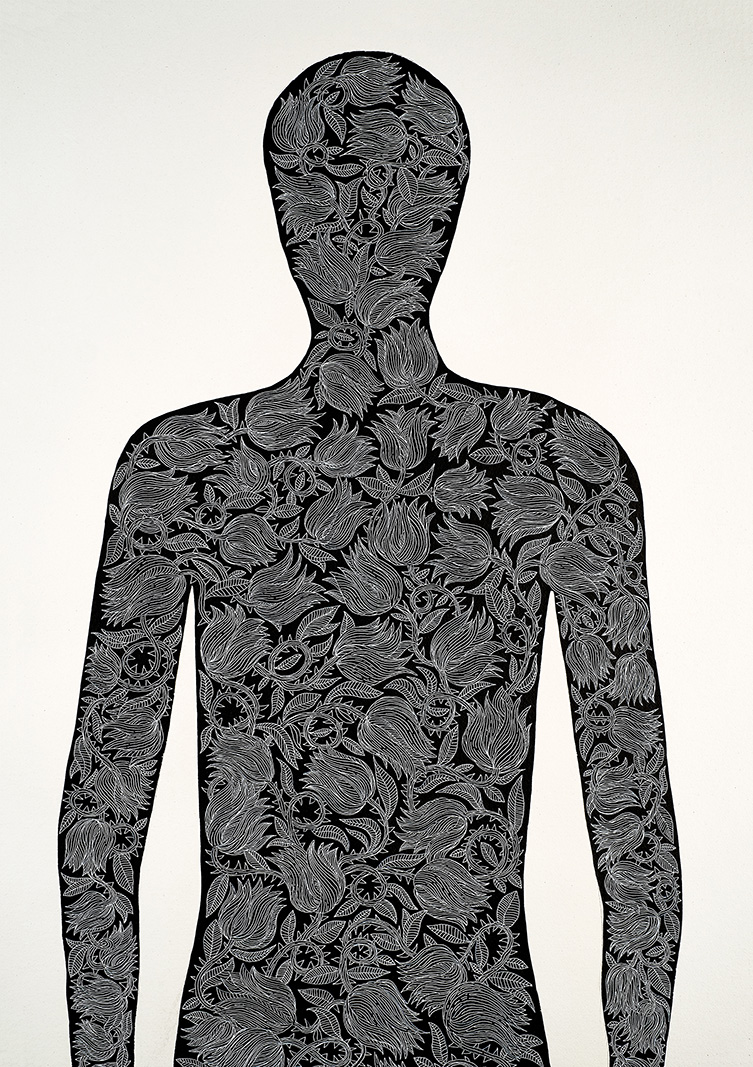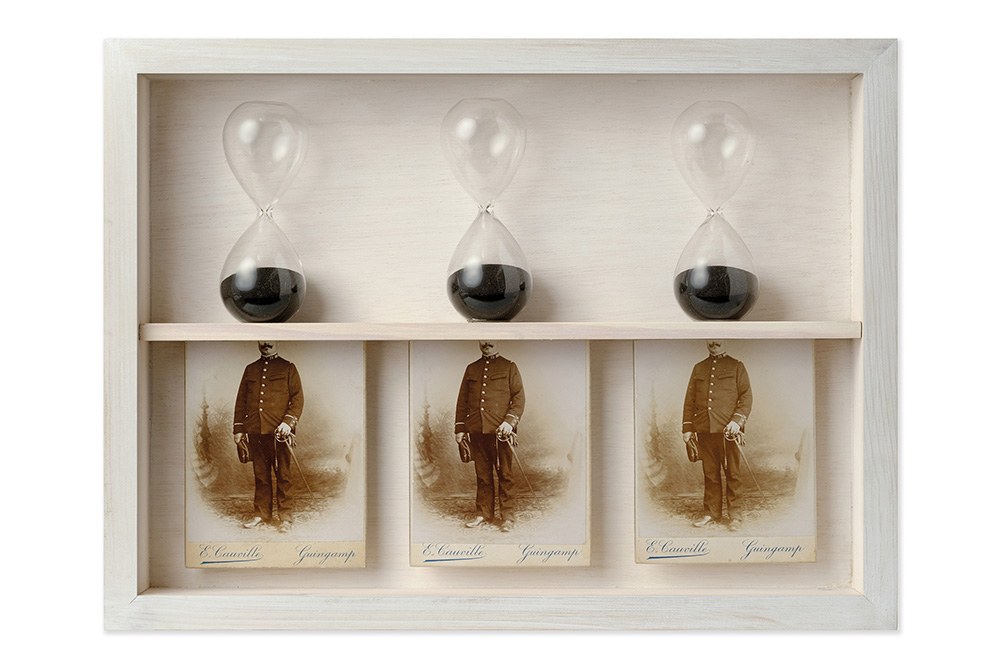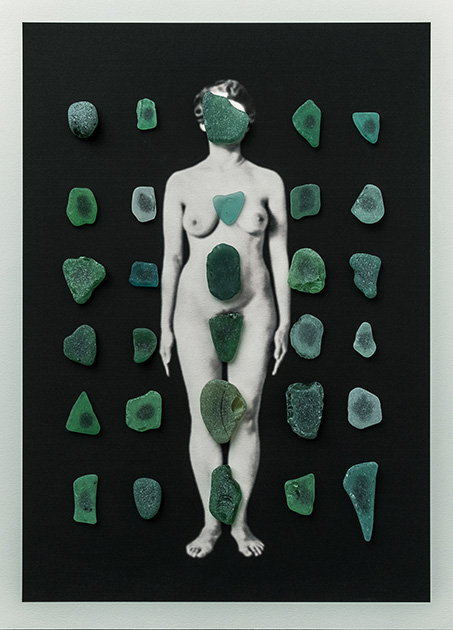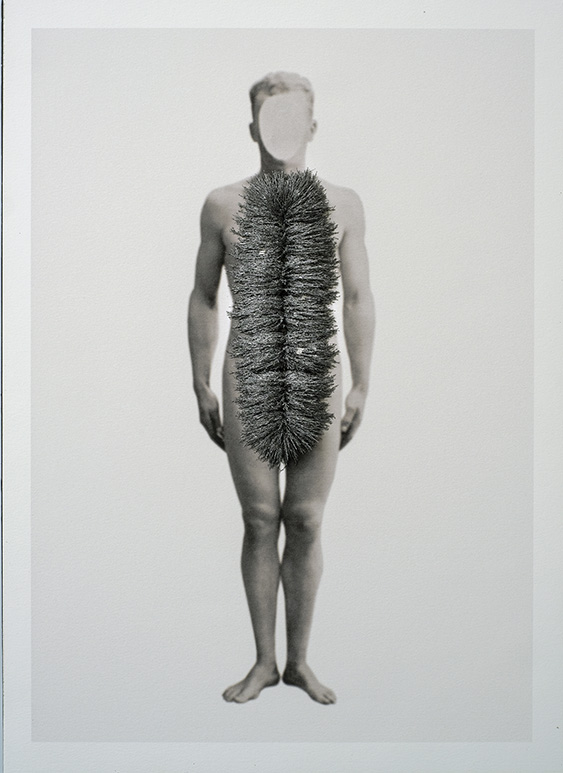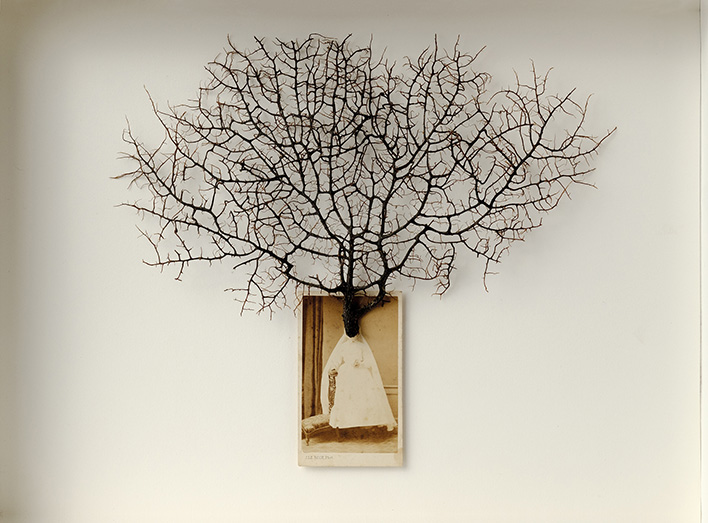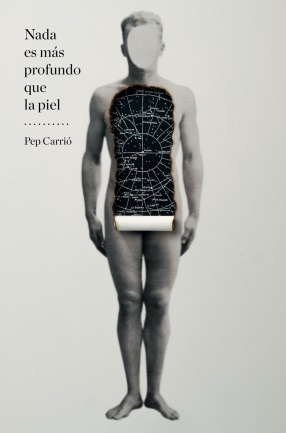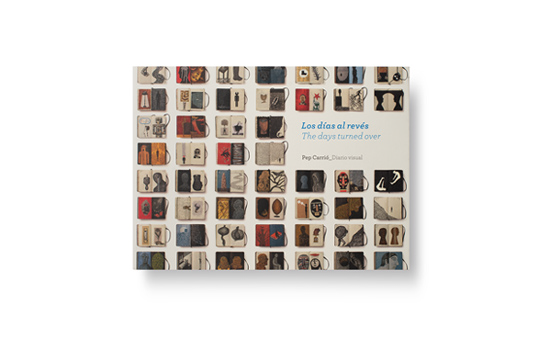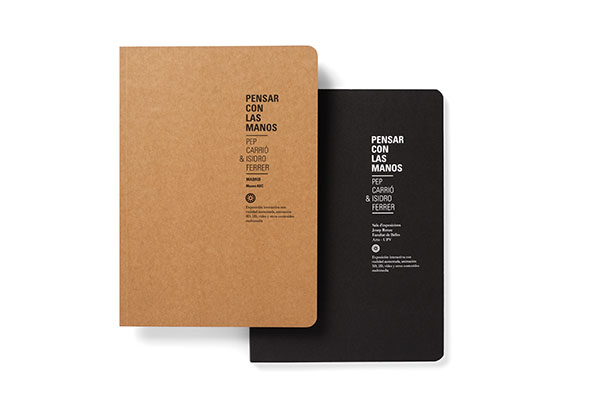
Nada es más profundo que la piel
Pep Carrió
07.11.18 – 5.01.19
“No hay nada más profundo que la piel”, el poema de Paul Válery, oracular y profético, abre perspectivas que se independizan de su autor para demostrar lo que el vate sabía: que la epidermis incierta del tiempo en la que se inscriben todas las narrativas habita en cada uno de nosotros. […]
En las piezas de Pep Carrió hay texturas que son textos enhebrados con la paciencia y el saber de quién quiere (¡y puede!) construir relatos que recuperan pieles de la vida, de diferentes vidas: ramas, fichas, botones, cordeles, fotos que son párrafos de historia. Trozos de historias en las que este poeta de la representación teje nuevas narraciones siempre abiertas, vertiginosas, inconclusas como una balsa que deambula en mares de orillas inalcanzables, entre la extrañeza de algo sido y la de aquello que podría ser pero todavía no existe y que tal vez nunca será. Cada pieza es una apertura novelística en la que se expone un nudo, ese inespecífico centro narrativo que -Dostoievski mediante- sabemos que es el centro del esquema del relato moderno.
Así es, la propuesta vertebral de presentación, nudo y desenlace que nos legó el autor ruso, significó a finales del siglo XIX, otorgarle protagonismo estelar al discurrir de la vida misma, antes subsumida en la trascendencia entre un nacer y un morir, entre una génesis y un apocalipsis. El nudo, los nudos, se reactivan en esta exposición donde cada propuesta es un hilo de Ariadna que cada cual tejerá a su manera, le pondrá sus personajes, los visibles y los invisibles, construirá una historia o una historieta, inventará un desenlace. Queda para quien dialoga con cada una -y con todas- las piezas, la apertura a inventar un comienzo; la precipitación de construir un desenlace. Pero a condición de adentrarse, de traspasar la corteza, es decir de imaginar, inventar, descubrir lo fantasmal e insólito que encierra cada obra, a modo de cada nudo, en su propia epidermis. Es decir, en sus profundidades. […]
Cristina Santamaría. Extracto de “Nada más profundo que la piel (Elogio a la paradoja)”
“There is nothing deeper than the skin,” the Paul Válery poem, oracular and prophetic, opens perspectives that become independent from its author to demonstrate what the vate knew: that the uncertain time’s epidermis is in where all the forms are inscribed. Narrative skills in each one of us. […]
In the pieces of Pep Carrió there are textures that are texts improved with the patience and knowledge of who wants (and can!) to build stories that recover skins of life, different branches, chips, buttons, strings, photos that are essentially, paragraphs of history. Pieces of stories in which this poet of representation weaves new narrations always open, dizzying, inconclusive as a raft that wanders in seas of unreachable shores, between the strangeness of something that can be and doesn’t exist or that maybe will never exist. Each piece is a novelistic opening in which a knot is exposed, a nonspecific narrative center that Dostoevsky understands as the center of the scheme in modern story.
Thus, the vertebral proposal of presentation, knot and outcome that the Russian author bequeathed to us, meant at the end of the 19th century, to grant star prominence to the course of life itself, previously subsumed in the transcendence between a being born and a dying, between a genesis and an apocalypse. The knots, are reactivated in this exhibition where each proposal is a thread of Ariadna that each one will weave in its own way. It will put its characters, visible and invisible, help build a story and invent an outcome. It remains for those who dialogue with each and every one of the pieces, the opening to invent a beginning; the precipitation of building an outcome. But on the condition of entering, of crossing the cortex, that is, of imagining, inventing, discovering the ghostly and unusual thing that each piece contains, like each knot, in its own epidermis. That is, in its depths. […]
Cristina Santamaría. Excerpt from “Nothing deeper than the skin (Praise to the paradox)”
Anatomías 3
Tinta china y rotulador sobre papel de la India Khadi, hecho a mano a partir de trapos reciclados. 2018. 80 x 200 cm
Anatomías 2
Pirograbado sobre papel de la India Khadi, hecho a mano a partir de trapos reciclados. 2018. 80 x 200 cm
Anatomía 4
Acrílico y rotulador blanco sobre papel de la India Khadi, hecho a mano a partir de trapos reciclados. 2018. 80 x 200 cm
Cuerpos 1
Caja de madera, fotografía impresa sobre papel Canson edition blanco natural 250 gr. y esqueletos de erizo de mar 27,5 x 38 cm. Ed.: Única / Unique
Cuerpos 2
Caja de madera, fotografía impresa sobre papel Canson Edition blanco natural 250 gr. e intervenida con rotulador blanco. 27,5 x 38 cm. Ed.: Única / Unique
Cuerpos 4
Serie: Cuerpos Caja de madera, fotografía impresa sobre papel Canson Edition blanco natural 250 gr. e intervenida con rotulador blanco 27,5 x 38 cm. Ed.: Única / Unique
Cuerpos 5
Serie: Cuerpos Caja de madera, fotografía impresa sobre papel Canson Edition blanco natural 250 gr. y agujas 27,5 x 38 cm. Ed.: Única / Unique
Cuerpos 6
Serie: Cuerpos Caja de madera, fotografía impresa sobre papel Canson Edition blanco natural 250 gr. y huesos 27,5 x 38 cm. Ed.: Única / Unique
Cuerpos 7
Serie: Cuerpos Caja de madera, fotografía impresa sobre papel Canson Edition blanco natural 250 gr. intervenida en pirograbado y mapa 27,5 x 38 cm. Ed.: Única / Unique
Cuerpos 8
Serie: Cuerpos Caja de madera, fotografía impresa sobre papel Canson Edition blanco natural 250 gr. intervenida en pirograbado 27,5 x 38 cm. Ed.: Única / Unique
Cuerpos 9
Caja de madera, fotografía impresa sobre papel Canson Edition blanco natural 250 gr. intervenida en pirograbado. 27,5 x 38 cm. Ed.: Única / Unique
Cuerpos 10
Caja de madera, fotografía impresa sobre papel Canson Edition blanco natural 250 gr. y agujas. 27,5 x 38 cm. Ed.: Única / Unique
Cuerpos 13
Caja de madera, fotografía impresa sobre papel Canson Edition blanco natural 250 gr. intervenida en pirograbado y mapa celeste . 27,5 x 38 cm. Ed.: Única / Unique
Cuerpos 3
Caja de madera, fotografía impresa sobre papel Canson Edition blanco natural 250 gr. y hojas de libro quemadas. 27,5 x 38 cm. Ed.: Única / Unique
Cuerpos 11
Caja de madera, fotografía impresa sobre papel Canson Edition blanco natural 250 gr. e intervenida con rotulador oro. 27,5 x 38 cm. Ed.: Única / Unique
Cuerpos 12
Caja de madera, fotografía impresa sobre papel Canson edition blanco natural 250gr. y cristales pulidos por el mar. 27 ́5 x 38 cm
Cuerpos 14
Caja de madera, fotografía impresa sobre papel Canson edition blanco natural 250gr. y cristales pulidos por el mar. 27 ́5 x 38 cm
Cuerpos 15
Caja de madera, fotografía impresa sobre papel Canson edition blanco natural 250gr. y conchas. 27 ́5 x 38 cm
Cuerpos 16
Caja de madera, fotografía impresa sobre papel Canson edition blanco natural 250gr. e hilo. 27 ́5 x 38 cm
Cuerpos 17
Caja de madera, fotografía impresa sobre papel Canson edition blanco natural 250gr. y espinas. 27 ́5 x 38 cm
Cuerpos 18
Caja de madera, fotografía impresa sobre papel Canson edition blanco natural 250gr. y limaduras de hierro. 27 ́5 x 38 cm
Cuerpos 19
Caja de madera, fotografía impresa sobre papel Canson edition blanco natural. 250gr. y coral 27 ́5 x 38 cm
Cuerpos 20
Caja de madera, fotografía impresa sobre papel Canson edition blanco natural 250gr. y dados. 7 ́5 x 38 cm
Enramado 1
Acrílico y rotulador sobre papel Indio Khadi, hecho a mano a partir de trapos reciclados. 2018. 55 x 78 cm
Enramado 2
Acrílico y rotulador sobre papel Indio Khadi, hecho a mano a partir de trapos reciclados. 2018. 55 x 78 cm
Inmersión 1
Acrílico y rotulador sobre papel Indio Khadi, hecho a mano a partir de trapos reciclados. 2018. 55 x 78 cm
Inmersión 2
Acrílico y rotulador sobre papel Indio Khadi, hecho a mano a partir de trapos reciclados. 2018. 55 x 78 cm
Inmersión 3
Pirograbado papel Indio Khadi, hecho a mano a partir de trapos reciclados. 2018. 41 ́5 x 59 cm
El fabricante de cabezas 2
Acrílico y semillas sobre papel secante. 2018. 121 x 81 cm sin marco 126 x 86 cm con marco
El fabricante de cabezas 3
Acrílico y rotulador sobre papel secante. 2018. 121 x 81 cm sin marco 126 x 86 cm con marco
El fabricante de cabezas 4
Pirograbado sobre papel secante. 2018. 121 x 81 cm sin marco 126 x 86 cm con marco
El fabricante de cabezas 5
Acrílico y rotulador blanco sobre papel secante. 2018. 121 x 81 cm sin marco 126 x 86 cm con marco
El fabricante de cabezas 6
Acrílico y rotulador sobre papel Indio Khadi, hecho a mano a partir de trapos reciclados. 2018. 55 x 78 cm
El fabricante de cabezas 7
Acrílico y rotulador sobre papel Indio Khadi, hecho a mano a partir de trapos reciclados. 2018. 55 x 78 cm
